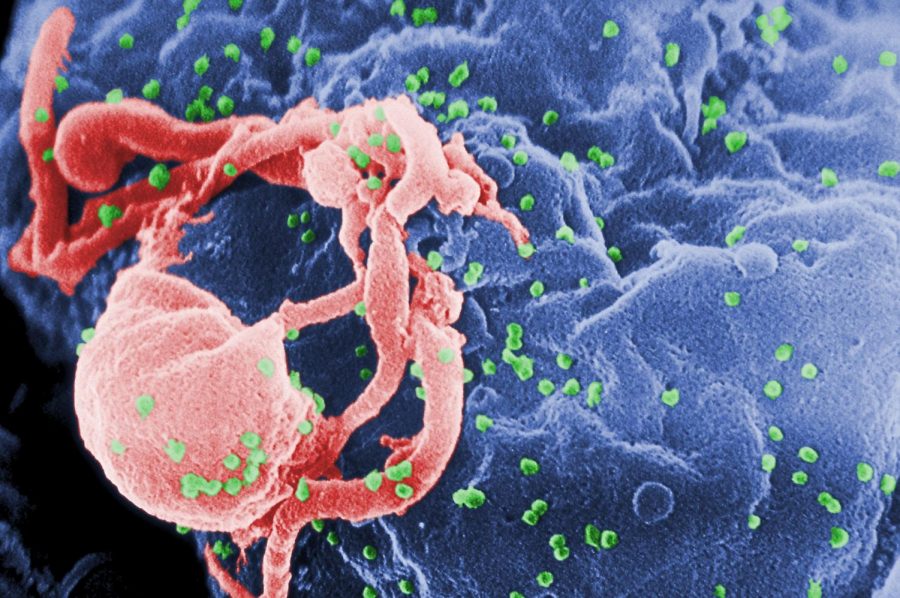Have Doctors Found a Cure for HIV?
HIV ATTACKS: HIV budding (in green) from a lymphocyte. The image has been colorized to emphasize important features.
May 8, 2019
One of the deadliest viruses in the world may be facing a new enemy: stem cells.
Doctors and scientists have announced that a London patient, whose identity remains anonymous, has been free of the Human Immunodeficiency Virus (HIV) for 18 months without any drugs or medication after undergoing a stem cell transplant.
HIV is a retrovirus that inserts its genetic material into an infected person’s DNA, allowing the infected DNA to produce the proteins that HIV needs for replication.
The virus itself does not directly kill the patient. It attacks the immune system, making the person susceptible to diseases and infections like cancer or tuberculosis that the body is too weak to fight off.
After being diagnosed with HIV in 2003, the London patient was later diagnosed with Hodgkin’s lymphoma–a type of cancer that attacks the immune system.
His doctors advised him to undergo a bone marrow transplant in which his blood cells would be destroyed and replaced with stem cells from a donor.
The donor needed a mutation–an alteration in the DNA sequence–in the CCR5 gene, which codes for a receptor where the HIV attaches to cells in order to infect them. The mutation in this gene, which scientists call the CCR5-delta 32 mutation, stops the virus from infecting the host’s cells halting further reproduction of infected cells and the virus itself.
Over 11 years ago, Timothy Ray Brown, then dubbed the “Berlin patient,” was announced to be HIV- and cancer-free after undergoing a similar process to the one that cured the London patient. Brown remains healthy and advocates for HIV awareness.
A third patient called the “Dusseldorf patient” has reportedly been freed of the virus for three months without antiretroviral treatment. But doctors say it is too early to tell if the patient has been cured.
With the exception of Brown, these patients are not entirely “cured” of the disease; they are merely “functionally cured” or in long term remission–meaning the virus is in very low quantities that it is undetectable in their bloodstreams. It is unsure whether the virus has been completely eradicated within the patient. There remains a risk of the virus coming back.
Furthermore, some doctors think that this procedure is not a definite cure for HIV. One of them is Dr. Michael Gottlieb, MD, who first identified AIDS as a disease and who currently works for AIDS Project Los Angeles (APLA) Health Center.
“I don’t think this strategy for cure is widely applicable,” said Dr. Gottlieb.
“Both patients required chemotherapy to nearly eradicate their original immune systems. Both patients had cancers justifying the risk, however most patients with HIV don’t have cancer.”
It is possible that the stem cell transplant treats the blood cancer with the eradication of the virus as a side effect. The transplant has never been proven to be successful on people with HIV alone.
The risky treatment also comes with its own costs and risks.
The surgery itself can be fatal as complications may arise–such as bleeding and infections. If the surgery proves to be successful, the body may reject the foreign cells, leading to death.
Brown was almost caught in this situation. After the surgery, he was purposely put in a medically-induced coma after his immune system began attacking his own cells. Brown needed to take immunosuppressants to prevent his body’s rejection of the donor cells.
“Furthermore, stem cell or bone marrow donors who are genetically resistant to HIV are very rare.” said Dr. Gottlieb.
The mutated cells used in the treatment are only found in about 10 percent of Northern Europeans and limiting the availability of the treatment to limited number of patients.
Hospital bills for post-operational monitoring also add significantly to the costs of an already expensive treatment.
Nevertheless, these three patients may help HIV/AIDS scientists look for a more definitive and less expensive cure for HIV and may stimulate more interest by researchers into gene therapy and the CCR5 gene.
“The cases represent what we call a proof of principle that HIV might be curable.” said Dr. Gottlieb.
General research on the virus has increased since it was identified in 1983, advancing tremendously since the early days when being infected was a death sentence. HIV researchers have drugs to extend the lives of millions of infected people.
Most patients undergo antiretroviral therapy (ART) by taking multiple drugs to hinder the growth of the virus in an infected person’s bloodstream, lowering the death rates and increased the life expectancies for infected people. However, mutations can arise once again, making the virus resistant to the drugs.
According to the Centers for Disease Control and Prevention (CDC), 1.1 million Americans are infected with HIV. Numbers may even be higher than reported since 1 in 7 people with HIV are unaware that they are infected.
With so many lives on the line, scientists are continuing their search for a more definite cure that can end the modern day plague.








